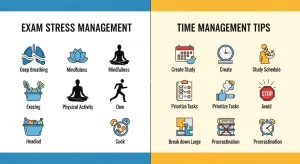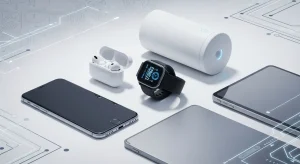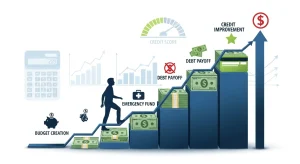Growing your own home vegetable garden has never been more rewarding or accessible. Whether you’re a complete beginner or looking to improve your gardening skills, this comprehensive guide will help you create a thriving vegetable garden that provides fresh, nutritious produce right from your backyard.
Why Start a Home Vegetable Garden?
Starting a home vegetable garden offers numerous benefits beyond just fresh produce. Vegetable gardening for beginners provides:
- Cost savings: Growing your own vegetables can reduce grocery bills by up to 600 dollars annually
- Better nutrition: Homegrown vegetables retain more vitamins and minerals than store-bought produce
- Environmental benefits: Reduced packaging waste and transportation emissions
- Physical activity: Gardening provides moderate exercise and stress relief
- Food security: Control over what goes into your food and growing methods
Top Free Productivity Apps for Students and Professionals
Planning Your Vegetable Garden Layout
Choosing the Perfect Location
The success of your backyard vegetable garden depends heavily on location. Look for these essential factors:
Sunlight Requirements:
- Most vegetables need 6-8 hours of direct sunlight daily
- Leafy greens can tolerate partial shade (4-6 hours)
- Root vegetables like carrots need full sun for proper development
Water Access:
- Choose a location within 50 feet of a water source
- Consider installing drip irrigation for consistent watering
- Avoid low-lying areas prone to waterlogging
Soil Quality:
- Test your soil pH (most vegetables prefer 6.0-7.0)
- Ensure good drainage to prevent root rot
- Amend clay or sandy soils with organic matter
Garden Size and Design
For vegetable gardening for beginners, start small and expand gradually:
- Beginner gardens: 4×4 feet or 4×8 feet raised bed
- Small families: 100 square feet (10×10 feet)
- Large families: 200-400 square feet
Garden Layout Options:
- Traditional in-ground garden: Most cost-effective for large spaces
- Raised bed gardening: Better drainage and soil control
- Container gardening: Perfect for small spaces and renters
- Square foot gardening: Maximizes yield in minimal space
Credit Scores Explained: How to Improve Yours Quickly
Essential Tools and Supplies for Vegetable Gardens
Basic Gardening Tools
Every successful home vegetable garden requires these essential tools:
Hand Tools:
- Trowel for planting and transplanting
- Hand pruners for harvesting and maintenance
- Garden fork for soil preparation
- Measuring tape for proper spacing
Larger Tools:
- Spade or shovel for digging
- Garden rake for soil smoothing
- Hoe for weeding
- Wheelbarrow or garden cart for transport
Soil Amendments and Fertilizers
Organic Matter:
- Compost (homemade or purchased)
- Well-aged manure
- Leaf mold
- Coconut coir
Natural Fertilizers:
- Fish emulsion for nitrogen
- Bone meal for phosphorus
- Kelp meal for potassium
- Rock dust for trace minerals
How to Start a Gratitude Journal and Stick to It
Best Vegetables for Beginner Gardens
Easy-to-Grow Vegetables
Start your vegetable gardening for beginners journey with these reliable crops:
Quick-Growing Options (30-60 days):
- Lettuce: Grows in cool weather, multiple harvests
- Radishes: Ready in 30 days, helps break up soil
- Spinach: Cold-tolerant, high in nutrients
- Green onions: Regrow from kitchen scraps
Beginner-Friendly Favorites:
- Tomatoes: High yield, versatile uses
- Beans: Fix nitrogen in soil, easy to grow
- Zucchini: Prolific producer, minimal care
- Carrots: Great for children, long storage life
Vegetables by Season
Cool Season Crops (Spring/Fall):
- Broccoli, cabbage, cauliflower
- Peas, fava beans
- Kale, arugula, mustard greens
Warm Season Crops (Summer):
- Tomatoes, peppers, eggplant
- Cucumbers, squash, melons
- Corn, okra, sweet potatoes
Container Gardening for Small Spaces
Container gardening offers flexibility for urban gardeners and those with limited space.
Container Selection
Size Requirements:
- Herbs: 6-8 inch diameter pots
- Lettuce/greens: 8-12 inch wide containers
- Tomatoes/peppers: 20-gallon containers minimum
- Root vegetables: 12-18 inch deep containers
Container Materials:
- Plastic: Lightweight, retains moisture
- Ceramic/clay: Attractive, good drainage
- Fabric pots: Excellent root development
- Recycled containers: Cost-effective option
Best Plants for Container Growing
Maximize your container garden success with these varieties:
- Cherry tomatoes: Compact, high-yielding
- Herbs: Basil, parsley, cilantro, thyme
- Peppers: Hot and sweet varieties
- Leafy greens: Lettuce, spinach, kale
Mindfulness Techniques for Reducing Everyday Stress
Step-by-Step Planting Guide
Soil Preparation
- Remove weeds and debris from the planting area
- Test soil pH and adjust if necessary
- Add 2-4 inches of compost to improve soil structure
- Till or dig soil to 8-12 inches deep
- Level and rake smooth before planting
Seed Starting vs. Transplants
Direct Seeding (plant seeds directly in garden):
- Root vegetables: carrots, radishes, beets
- Large seeds: beans, corn, squash
- Cool-season crops: peas, lettuce, spinach
Transplants (start indoors or buy seedlings):
- Heat-loving crops: tomatoes, peppers, eggplant
- Long-season crops: broccoli, cabbage
- Small seeds: herbs, celery
Proper Planting Techniques
Seed Depth Rule: Plant seeds at a depth equal to 2-3 times their diameter
Spacing Guidelines:
- Small plants: 4-6 inches apart (lettuce, herbs)
- Medium plants: 12-18 inches apart (peppers, broccoli)
- Large plants: 24-36 inches apart (tomatoes, squash)
Houseplants That Thrive Indoors: A Beginner’s Guide
Garden Maintenance and Care
Watering Best Practices
Proper watering is crucial for vegetable garden success:
Watering Schedule:
- Deep, infrequent watering encourages root development
- Morning watering reduces disease risk
- 1-2 inches per week including rainfall
Watering Methods:
- Drip irrigation: Most efficient
- Soaker hoses: Good for rows
- Hand watering: Best for containers
- Sprinklers: Avoid during humid conditions
Pest and Disease Management
Organic Pest Control:
- Companion planting: Marigolds deter nematodes
- Beneficial insects: Attract ladybugs and lacewings
- Row covers: Physical barrier against pests
- Neem oil: Natural insecticide and fungicide
Disease Prevention:
- Crop rotation: Prevent soil-borne diseases
- Proper spacing: Improve air circulation
- Clean tools: Prevent disease spread
- Remove infected plants immediately
Harvesting and Storage
When to Harvest Common Vegetables
Peak Harvest Times:
- Tomatoes: When fully colored but still firm
- Lettuce: Harvest outer leaves continuously
- Beans: Pick when pods are tender and snap easily
- Carrots: Ready when shoulders are visible at soil level
Storage Methods
Short-term Storage:
- Refrigerator: Leafy greens, herbs (1-2 weeks)
- Counter: Tomatoes, peppers (3-7 days)
- Cool, dark place: Onions, potatoes (1-3 months)
Long-term Preservation:
- Freezing: Blanch vegetables before freezing
- Canning: Follow safe canning procedures
- Dehydrating: Great for herbs and tomatoes
- Fermentation: Sauerkraut, pickles
Budget-Friendly Home Renovation Tips that Last
Common Beginner Mistakes to Avoid
Planning Mistakes
- Starting too large: Begin with a manageable size
- Poor location choice: Insufficient sunlight or water access
- Ignoring soil preparation: Foundation of garden success
- Planting everything at once: Stagger plantings for continuous harvest
Growing Mistakes
- Overwatering: More plants die from too much water than too little
- Overcrowding: Follow spacing recommendations
- Neglecting maintenance: Regular care prevents major problems
- Using contaminated tools: Clean tools between plants
FAQ Section
What’s the best time to start a home vegetable garden?
The ideal time depends on your location and chosen vegetables. For cool-season crops like lettuce and peas, plant 2-4 weeks before the last frost. Warm-season vegetables like tomatoes and peppers should be planted after all danger of frost has passed. Consult your local agricultural extension office for specific planting dates in your area.
How much space do I need for a beginner vegetable garden?
A beginner vegetable garden can be as small as 4×4 feet. This space can accommodate 4-6 different vegetable varieties using square foot gardening methods. Container gardening requires even less space – a sunny balcony or patio can support several containers growing herbs, lettuce, and cherry tomatoes.
What vegetables are easiest for beginners to grow?
The easiest vegetables for vegetable gardening for beginners include lettuce, radishes, green beans, zucchini, and herbs like basil and cilantro. These crops are forgiving, grow quickly, and require minimal specialized care. Start with 3-5 of your favorite vegetables rather than attempting to grow everything at once.
How often should I water my vegetable garden?
Most vegetable gardens need about 1-2 inches of water per week, including rainfall. Water deeply but less frequently to encourage deep root growth. Check soil moisture by inserting your finger 2 inches into the soil – if it’s dry, it’s time to water. Container gardens typically need daily watering during hot weather.
Can I grow vegetables without a yard?
Absolutely! Container gardening allows you to grow vegetables in small spaces like balconies, patios, or even sunny windowsills. Many vegetables thrive in containers, including tomatoes, peppers, herbs, leafy greens, and root vegetables. Choose containers with drainage holes and use high-quality potting soil for best results.
10 Timeless Fashion Staples Every Wardrobe Needs
Conclusion: Start Your Vegetable Garden Journey Today
Starting a home vegetable garden is one of the most rewarding ways to connect with your food and improve your family’s nutrition. Whether you choose traditional in-ground gardening, raised bed gardening, or container gardening, the key to success lies in proper planning, consistent care, and patience.
Remember that every expert gardener was once a beginner. Start small, learn from your mistakes, and enjoy the process of growing your own fresh vegetables. Your backyard vegetable garden will provide not just nutritious food, but also a sense of accomplishment and connection to the natural world.
Ready to start your vegetable gardening journey? Check out our recommended starter seed collection and essential gardening tools to get your home vegetable garden growing today!











